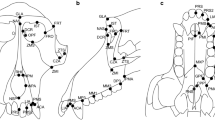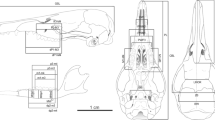Abstract
As a first step in reviewing the classification of the two stump-tailed macaque species,Macaca arctoides andM. thibetana, as compared with other species of the genusMacaca, 72 linear dental and cranial variables of 11 macaque species were examined by morphometric analyses. The results indicate that the two stump-tailed species are the largest of the macaques and although rather similar overall, they exhibit significant differences in the pattern of variation in most of the five skull regions as shown by Principal Components and Canonical Variate Analyses. Euclidean Distances based on Canonical Variate scores indicate that the females ofM. arctoides andM. thibetana are more widely separated than eight other pairs of macaque species, and that the separations of the respective males are greater than those of three other pairs of species. These findings are consistent withFooden's classification of the stump-tailed macaques as two separate species (Fooden, 1976;Fooden et al., 1985). The present results suggest, as other researchers have proposed on the basis of external features, biochemistry and genetics, that the two stump-tailed macaque species andM. assamensis are closely related. The results also tentatively imply associations withM. fuscata andM. sylvanus but these require further study. The findings have implications for the assessment of the various Chinese Pleistocene macaque fossils.
Similar content being viewed by others
References
Albrecht, G. H. 1978.The Craniofacial Morphology of the Sulawesi Macaque: Multivariate Approaches to Biological Problems, Contributions to Primatology, 13. S. Karger, Basel.
Albrecht, G. H.;Miller, J. M. A. 1993. Geographic variation in primates: a review with implication for interpreting fossils. In:Species, Species Concepts, and Primate Evolution,Kimbel,W. H.;Martin,L. B. (eds.), Plenum, New York, pp. 123–161.
Cronin, J. E.;Cann, R.;Sarich, V. M. 1980. Molecular evolution and systematics of the genusMacaca. In:The Macaques: Studies in Ecology, Behaviour and Evolution,Lindburg,D. G. (ed.), Van Nostrand Reinhold, New York, pp. 31–51.
Darga, L. L.;Goodman, M.;Weiss, M. L.;Moore, G. W.;Prychodko, W.;Dene, H.;Tashina, R.;Koen, A. A. 1975. Molecular systematics and clinal variation in macaques. In:Isoenzymes IV Genetics and Evolution,Markert,C. L. (ed.), Academic Press, New York, pp. 797–812.
Delson, E. 1980. Fossil macaques, phyletic relationships and a scenario of development. In:The Macaques: Studies in Ecology, Behaviour and Evolution,Lindburg,D. G. (ed.), Van Nostrand Reinhold, New York, pp. 10–30.
Dittus, W. P. J. 1980. The social regulation of primate populations: a synthesis. In:The Macaques: Studies in Ecology, Behaviour and Evolution,Lindburg,D. G. (ed.), Van Nostrand Reinhold, New York, pp. 263–286.
Ellerman, J. R.;Morrison-Scott, T. C. S. 1951.Checklist of Palaearctic and India Mammals, 1758–1946. Trustees of Brit. Mus. Nat. Hist., London.
Ellerman, J. R.;Morrison-Scott, T. C. S. 1966.Checklist of Palaearctic and India Mammals, 1758–1946. Brit. Mus. Nat. Hist., London.
Elliot, D. G. 1912.A Review of the Primates, Vol. 2. Amer. Mus. Nat. Hist., New York.
Fa, J. E. 1989. The genusMacaca: a review of taxonomy and evolution.Mammal. Rev., 19(2):45–81.
Fooden, J. 1967a. Complimentary specialization of male and female reproductive structures in the bear macaque,Macaca arctoides.Nature, 214:939–941.
Fooden, J. 1967b. Identification of the stump-tailed monkey,Macaca speciosa:I. Geoffroy, 1926.Folia Primatol., 5: 153–164.
Fooden, J. 1969. Taxonomy and evolution of monkeys of Celebes (Primates: Cercopithecidae).Bibl. Primatol., 10:1–148.
Fooden, J. 1976. Provisional classification and key to the living species of macaques (primates:Macaca).Folia Primatol., 25: 225–236.
Fooden, J. 1980. Classification and distribution of living macaques (Macaca Lecépède, 1799). In:The Macaques: Studies in Ecology, Behaviour and Evolution,Lindburg,D. G. (ed.), Van Nostrand Reinhold, New York, pp. 1–9.
Fooden, J. 1982a. Taxonomy and evolution of theSinica group of macaques: 3. species and subspecies account ofMacaca assamensis.Fieldiana Zool. (New York Series), 10: 1–52.
Fooden, J. 1982b. Ecogeographic segregation of macaque species.Primates, 23: 574–579.
Fooden, J. 1983. Taxonomy and evolution of thesinica group of macaques: 4. species account ofMacaca thibetana.Fieldiana Zool., 17: 1–20.
Fooden, J. 1986. Taxonomy and evolution of thesinica group of macaques: 5. overview of natural history.Fieldiana Zool., 29: 1–22.
Fooden, J. 1988. Taxonomy and evolution of thesinica group of macaques: 6. interspecific comparisons and synthesis.Fieldiana Zool., 45: 1–44.
Fooden, J. 1990. The bear macaque,Macaca arctoides: a systematic review.J. Human Evol., 19: 607–686.
Fooden, J.;Quan, G.-Q.;Wang, Z.-R.;Wang, Y.-X. 1985. The stumptail macaques of China.Amer. J. Primatol., 8: 11–30.
Goodman, M.;Kulkarni, A.;Poulik, E.;Keklys, E. 1965. Species and geographic differences in the transferrin polymorphism of macaques.Science, 147: 884–886.
Groves, C. P. 1980. Speciation inMacaca: the view from Sulawesi. In:The Macaques: Studies in Ecology, Behaviour and Evolution,Lindburg,D. G. (ed.), Van Nostrand Reinhold, New York, pp. 84–124.
Hair, J. F. Jr.; Anderson, R. E.; Black, W. C. 1992.Multivariate Data Analysis with Reading. Maxwell Macmillan Canada, Maxwell and Macmillan International, Macmillan Publ., pp. 193–264.
Hill, W. C. O. 1974.Primates: Comparative Anatomy and Taxonomy, vol. VII: Cynopithecinae (Cercocebus, Macaca, Cynopithecus). Edinburgh Univ. Press, Edinburgh.
Inagaki, H. 1996. Some hair characteristics ofMacaca monkeys and an attempt to group them based on those features. In:Variation in the Asian Macaques,Shotake,T.;Wada,K. (eds.), Tokai Univ. Press, Japan, pp. 89–96.
Lele, S.;Richtsmeier, J. T. 1991. Euclidean distance matrix analysis: a coordinate system free approach for comparing biological shapes using landmark data.Amer. J. Phys. Anthropol., 86: 415–427.
Lele, S.;Richtsmeier, J. T. 1992. On comparing biological shapes: detection of influential landmarks.Amer. J. Phys. Anthropol., 87: 49–65.
Lele, S.;Richtsmeier, J. T. 1995. Euclidean distance matrix analysis: confidence intervals for form and differences.Amer. J. Phys. Anthropol., 98: 73–86.
Melnick, D. J.;Kidd, K. 1985. Genetic and evolutionary relationships among Asian macaques.Int. J. Primatol., 6: 123–160.
Mouri, T. 1994. Distribution of lacrimal lacrimal fossa in cercopithecids.Anthropol. Sci., 102(4): 395–407.
Napier, J. R.;Napier, H. A. 1967.A Handbook of Living Primates. Academic Press, London.
Norusis, M. J. 1993. SPSS for Windows™, Professional Statistics™, Release 6.0. SPSS.
Nozawa, K.;Shotake, T.;Ohkura, T.;Tanabe, Y. 1977. Genetic variations within and between species of Asian macaques.Jap. J. Genet., 52: 15–30.
Oxnard, C. E. 1997. The interface of function, genes, development and evolution: insights from primate morphometrics.Perspective in Human Biol., 3: 85–119.
Oxnard, C. E. 1998. Information content of morphometric data in primates: function, development and evolution. In:Primate Locomotion: Recent Advance,Strasser,E. (ed.), Plenum, New York & London, pp. 255–275.
Oxnard, E.;Pan, R. L.;Jablonski, N. G.;Freedman, L. 1997. The structure of the macaque skull as revealed by morphometric analysis.Amer. J. Phys. Anthropol. (Suppl.), 24: 181–182.
Pan, R. L. 1998. A craniofacial study of the genusMacaca, with special reference to the stump-tailed macaques,M. arctoides andM. thibetana. Ph. D. thesis, The Univ. of Western Australia, Australia.
Pan, R. L.;Jablonski, N. G. 1995. Sexual dimorphism in canine size inMacaca.Amer. J. Phys. Anthropol. (Suppl.), 20: 166–167.
Plavcan, J. M. 1990. Sexual dimorphism in the dentition of extant Anthropoid primates. Master thesis, UMI Diss. Inform. Service, Univ. Microfilms International A Bell & Howell Information, USA
Plavcan, J. M. 1993. Canine size and shape in male Anthropoid primates.Amer. J. Phys. Anthropol., 92: 201–216.
Pocock, R. I. 1926. The external characters of the catarrhine monkeys and apes.Proc. Zool. Soc. Lond., 1925: 1479–1579.
Takahashi, L. K.;Pan, R. L. 1994. Mandibular morphometrics among macaques: the case ofMacaca thibetana.Int. J. Primatol., 15: 597–621.
Tate, G. H. 1947.Mammals of Eastern Asia. The Macmillan, New York.
Taub, D. M. 1980. Female choice and mating strategies among wild Barbary macaques (Macaca sylvanus L.). In:The Macaques: Studies in Ecology, Behaviour and Evolution,Lindburg,D. G. (ed.), Van Nostrand Reinhold, New York, pp. 287–344.
Wada, K.;Xiong, C.-P. 1996. Population changes of Thibetan monkeys with special regard to birth interval. In:Variation in the Asian Macaques,Shotake,T.;Wada,K. (eds.), Tokai Univ. Press, Japan, pp. 133–145.
Zhang, Y.-P. 1991. Intra- and inter-specific polymorphism of the mitochondrial DNA in macaques. Ph. D. thesis, Kunming Instit. Zoology, China. (in Chinese)
Zhang, Y.-P.;Shi, L.-M. 1993. Phylogenetic relationships of macaques as inferred from restriction endonuclease analysis of mitochondrial DNA.Folia Primatol., 60: 7–17.
Zhang, Y.-Z.;Qiang, G.-Q.;Tigong, Z.;Southwick, C. H. 1991. Distribution of macaques (Macaca) in China.Acta Theriol. Sinica, 11: 171–185.
Zhang, Y.-Z.;Wang, Y.-X.;Quan, Q.-G. 1981. On the geographic distribution of primates in China.J. Human Evol., 10: 215–260.
Zhao, Q.-K. 1994a. Seasonal changes in body weight ofMacaca thibetana at Mt. Emei, China.Amer. J. Primatol., 32: 223–226.
Zhao, Q.-K. 1994b. Mating competition and intergroup transfer of males in Tibetan macaques (Macaca thibetana) at Mt. Emei, China.Primates, 35: 57–68.
Author information
Authors and Affiliations
About this article
Cite this article
Pan, R., Jablonski, N.G., Oxnard, C. et al. Morphometric analysis ofMacaca arctoides andM. thibetana in relation to other macaque species. Primates 39, 519–537 (1998). https://doi.org/10.1007/BF02557573
Received:
Accepted:
Issue Date:
DOI: https://doi.org/10.1007/BF02557573




